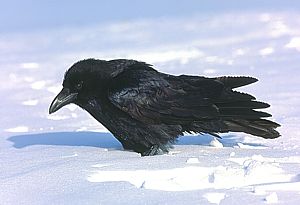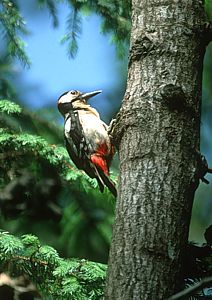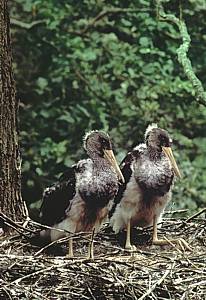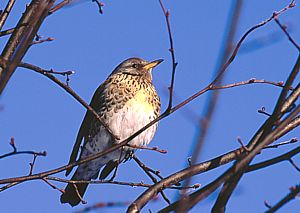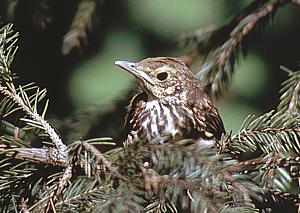|
BIRDS
|
||||||||||||||
Text:
|
Forest birds
Forests constitute over 60% of the overall area of Wigry National Park. In the northern parts you can observe hornbeam-reed forests and in Southern parts the sub boreal mixed wood. Depending on the type of the forest one can meet different bird species. In warm pine forests one can meet e.g. great spotted woodpecker Dendrocopos major, crested tit Parus cristatus, coal tit Parus ater, tree pipit Anthus trivialis and chaffinch Fringilla montifringilla. In mixed forests we will meet e.g. raven Corvus corax, middle spotted woodpecker Dendrocopos medius, Eurasian treecreeper Certhia familiaris, great tit Parus major, black stork Ciconia nigra, song thrush Turdus philomelos and robin Erithacus rubecula. European green woodpecker Picus viridis, Eurasian nuthatch Sitta europea, fieldfare Turdus pilaris, Eurasian blue tit Parus caeruleus and European pied flycatcher Ficedula hypoleuca.
Raven Corvus corax belongs to the raven family. Its body is about 65 cm long, the spread of wings is about ok. 125 cm, the weight varies from 1000 to 1500 g. The plumage is completely black with metallic polish, beak and legs are black as well. Raven lives in forests, mountains and rocky sea-coasts. It eats the carrion, hunts for rodents, birds and their eggs, amphibians, reptiles, smaller mammalians and insects, too. His behavior is similar to that of predacious birds - the trophy is carried in the claws rather than in the beak; it willingly revolves high in the air, performing aerial evolutions. It has got a perfectly fully developed sense of hearing and eyesight. It is a long-lived bird, there were cases of ravens living in slavery up to 100 years. Raven can be found on the borders of high forests, meadows and fields. In the past raven was thought to be a shy bird, avoiding the close neighborhood of man; nowadays more and more often its nests can be found in the vicinity of villages and cities. The nest, built on trees, is made from sticks, the ground, dry grasses, moss and hair. It starts the breeding season very early. The female lays 4-6 eggs in the second half of February or at the beginning of March which are incubated by her. The young leave the nest after about 40 days, however they stay in the family up to the autumn period. Ravens seldom get together in herds. They live in our climate the whole year.
Great spotted woodpecker Dendrocopos major belongs to the woodpecker family. The length of body is about 23 cm, the spread of wings is about 44 cm, the weight of body reaches about 80 g. The plumage is red-black-white; there is a red head-band on the occiput. It lives in different types of forests, parks and avenues. It mainly eats insects; in autumn and in winter it additionally eats seeds of (hazels and coniferous trees). Long, strong beak serves to hammer the holes in the wood and to split off barks in search of insects. In order to extract small insects and their larva's it uses a very long, moving and sticky tongue. It often collects pine cones which are inserted into the hole in a tree and in crevices of bark. Having accumulated the cones, later on it splits them eating the hidden seeds. Woodpecker the great has comparatively short legs with four fingers; two of them directed forward; two of them directed to the back. Thanks to such limb construction and thanks to sharp claws woodpecker can move by slow leaps on the perpendicular surfaces of the tree trunks, leaning with its stiff tail. The nest is built in a hammered hole in a tree at the height of 0,5 to 2 m. In the first half of May the female lays 5-7 of eggs which are incubated by both parents. At first the young are very infirm, however intensely fed by parents quickly grow and become independent. They leave the nest after three weeks.
Black stork Ciconia nigra belongs to the stork family. It is a bit smaller than the white stork; the length of its body is about 97 cm, the spread of wings is about 190 cm, the weight of body reaches about 3000 g. With exception to the bottom of the body which is white, the plumage is black. The legs and beak are red. It lives in extensive forests abounding in water reservoirs, swamps and wet meadows; it avoids the neighborhood of man. In comparison to the white stork it does not find the food on the fields and meadows, but among swamps or on the banks of rivers and ditches where it wades in the shallow water hunting for water animals. It eats water insects, fishes, amphibians and reptiles. It does not create the breeding colonies. The nest is built on a high tree, in a quiet place, deep inside the forest. Sometimes it uses the lonesome nests of predacious birds. At the turn of April and May the female lays 3-5 eggs. The young stay in the nest for about 60-70 days. At first the young are brown and when they are three years old their plumage turns black with a rainbow-hued polish. Black stork flies to us in March and flies away in August - October. It spends the winter period in the eastern and south Africa and India.
Fieldfare Turdus pilaris belongs to the thrush family. The length of body is 27 cm, the length of wing is about 15 cm, the weight reaches about 100 g. The plumage is tawny-grey; the chest and throat has got black spots. It lives on the edges of moist forests, old parks and forestation placed in the valleys of rivers. It eats insects and other invertebrates; in autumn it also eats berries (it is especially keen on juniper berries). The nests, often found in colonies, are built on the leafy trees at the height of 4-7 m. The nest is made from leaves, grasses, clays or loam. At the end of April the female lays 5-6 of eggs. The young leave the nest after 2 weeks, before even learning to fly. After the breeding season they form herds consisting of tens of individuals. They fly to us in March and April and fly away in October and November. They spend the winter period in the southern and western Europe, Asia Minor and India. At the time of winter one can observe here Turdus pilaris from the north.
Song thrush Turdus philomelos belongs to the thrush family. Its body is about 23 cm long, the length of wing is about ok. 12 cm, the weight of body reaches about ok. 60 g. The plumage is grey and brown with black oblong spots. Its name was given due to the high vocal skills. Except for the complicated mating singing - this bird produces other voices depending on the situation, e.g. when uneasy it produces the sound reminding a quickly opened and closed scissors. It lives in different types of forests and parks. It mainly eats insects and other small invertebrates; in autumn it also eats berries. The nest, made from leaves of plants, moss, rotten woods and saliva, is built on shrubs or trees. It has two breeding seasons, starting from the end of April to June. The female lays 4-5 of eggs; having hatched the young leave the nest after 2 weeks. It flies to us at the end of March and flies away in September - October. It spends the winter period in the south-west parts of Europe, North Africa and Asia Minor.
|
|||||||||||||
|
|
|
